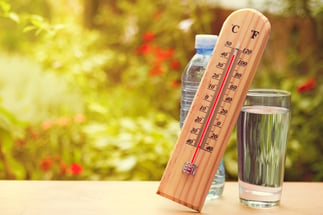 Many people are exposed to heat on the job, outdoors, or in hot indoor environments. Operations involving high air temperatures, radiant heat sources, high humidity, direct physical contact with hot objects, or strenuous physical activities have a high potential for causing heat-related illness. When the body is unable to cool off by sweating, heat-induced illnesses, such as heat rash, cramps, heat exhaustion, and heat stroke can occur. These illnesses can be serious, sometimes even resulting in death. However, these illnesses and deaths are preventable.
Many people are exposed to heat on the job, outdoors, or in hot indoor environments. Operations involving high air temperatures, radiant heat sources, high humidity, direct physical contact with hot objects, or strenuous physical activities have a high potential for causing heat-related illness. When the body is unable to cool off by sweating, heat-induced illnesses, such as heat rash, cramps, heat exhaustion, and heat stroke can occur. These illnesses can be serious, sometimes even resulting in death. However, these illnesses and deaths are preventable.
Common factors that can all contribute to heat stress:
- High temperature and humidity
- Direct sun or heat
- Limited air movement
- Physical exertion
- Poor physical condition
- Some medications
- A lack of tolerance for hot workplaces or areas
Heat Stress Prevention
- Know the signs and symptoms of heat-related illnesses, and monitor yourself and your co-workers.
- Block or avoid direct sunlight or other heat sources.
- Use cooling fans or air conditioning.
- Take regular breaks in shaded areas.
- Drink plenty of water or high-electrolyte fluids.
- Wear lightweight, light-colored, and loose-fitting clothing.
- Avoid alcohol, caffeinated drinks, and heavy meals.
- If you detect signs of heat exhaustion, notify a supervisor or appropriate individual with first aid training.
When you or a coworker appears to be expressing signs of heat stress, determining the severity is important in order to take the appropriate first aid actions. Below are 4 signs of heat stress to be aware of.
- Move the affected person to a cool, shaded or air-conditioned area.
- Give cool (not cold) water only if the individual is conscious.
- Cool the individual by fanning, misting with water, or applying ice packs.
- If necessary, loosen or remove heavy clothing.
For more information about workplace safety and preventing heat related illnesses, contact your Knowledge Broker or email safety@rrins.com.

